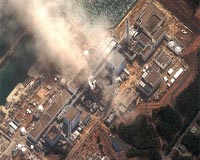 |
Paris (AFP) March 28, 2011 Critically damaged reactors at the Fukushima nuclear plant are still leaking radioactive pollution into the air, and probably into the soil and sea, say experts. Here's an update on the nature of the damage, and just how bad things could get: Q: How serious is contamination at the nuclear facility? A: Radioactivity levels at the Fukushima plant are very high due to gaseous discharges and leakage from inside the some of the reactor vessels. The discovery of dangerously irradiated water inside the outer buildings of two reactors has made the task of workers at the site both difficult and dangerous. Tests have shown "a very high concentration -- equivalent to a dose of 1,000 millisieverts (mSv) per hour -- in reactor 2, and 750 mSv in reactor 3," France's Nuclear Safety Authority (ASN) said. "Someone who stands next to such water will, within 15 minutes, absorb the maximum dose a nuclear facility worker in Japan is allowed to take in during an entire year," or 250 mSv, said Thierry Charles, head of France's Institute for Radiological Protection and Nuclear Safety (IRSN). Even the 250 mSv limit -- set at the outset of the Fukushimia crisis -- is two-and-a-half times more than what had been the long-standing ceiling. The plant's operator, Tokyo Electric Power Co. (TEPCO), acknowledged Monday for the first time that highly radioactive water has leaked from the buildings housing both of these reactors, and has already reached the Pacific Ocean. Concentrations of iodine 1,000 to 2,000 times above normal -- but still below the danger threshold, according to experts -- has been detected in adjacent coastal waters. Iodine 131 is relatively short-lived, decreasing in radioactivity by half every eight days. By contrast, cesium 137 -- with a so-called "half-life" of 30 years rather than eight-days -- is more likely to concentrate in sediment below shallow waters. Both elements have spread through the air "well beyond" the 30-kilometre exclusion zone around Japan's Fukushima nuclear plant, though not in concentrations likely to be directly hazardous to human health, the ASN said Monday. Slightly radioactive plumes carried by winds across the Pacific and to Europe are without health consequences, experts say. Q: Where does the radioactive water near reactors 2 and 3 come from? A: The contaminated water inside the building housing reactor 2 is most likely leakage from the donut-shaped suppression chamber, or "wet well," circling the foot of the protective steel-and-concrete casing, or "dry well," around the reactor vessel, according to ASN and IRSN. Emergency workers are searching for a method to pump out the radioactive water a metre (three feet) deep and collect it. Up to 1.5 metres of contaminated water has also been found in reactor 3's turbine room. TEPCO is now injecting fresh water inside reactor 3's pressure vessel to cool the core's fuel rods. The leaks in both reactors, experts say, mean that this innermost line of defence has been breached. "There are gas leaks -- water vapour that escapes, carrying radioactive particles -- and then there is also water leaking out, perhaps through tubes or pipes," Charles said. Q: Do contamination levels mean that the cores of reactors 2 and 3 have melted? A: To some extent, at least. "The core is certainly very degraded, and we think it has experienced partial meltdown," said Charles. Unfortunately, disabled monitors and gauges make it impossible to determine water levels in spent fuel pools, or to know what percentage of fuel rods in the reactors might have melted. "But it is certain that, inside the reactor core, there must be some pieces that have melted to form corium," or molten fuel composed of the rods and other structural elements. Q: What, at this point, is the worst-case scenario? A: If the corium burns through the containment vessel's concrete floor or other protections, that boosts the risk that radioactivity can enter the environment through the soil. "The corium attacks the concrete, and starts to pierce it while at the same time creating potentially inflammable and explosive gas," Charles said. But if the corium is cooled with water, it is highly unlikely that it could melt through eight metres (26 feet) of concrete, he added. Even in an extreme scenario where there is enough corium to pierce the containment vessel, the molten matter will cool slowly as it hits the rock foundation under the nuclear reactor, according to IRSN experts. Water running over the corium would carry radioactive elements into the ocean. But the impact would still be a far cry from the volcanic blast of radioactive material thrown up into the air by the 1986 explosion at the Chernobyl reactor. "Chernobyl was an openly exposed core burning for 12 days, maximising the outpouring," said Charles.
Share This Article With Planet Earth
Related Links Bringing Order To A World Of Disasters A world of storm and tempest When the Earth Quakes
 Plutonium detected in soil at Japan nuclear plant
Plutonium detected in soil at Japan nuclear plantSendai, Japan (AFP) March 28, 2011 Plutonium has been detected in soil at a stricken nuclear plant in Japan and highly contaminated water has leaked from a reactor building, the operator said Monday, fanning environmental fears. Radiation worries have disrupted efforts to restart the cooling system of the Fukushima Daiichi plant, which was battered by a huge earthquake and tsunami on March 11 that left more than 28,000 people ... read more |
|
| The content herein, unless otherwise known to be public domain, are Copyright 1995-2010 - SpaceDaily. AFP and UPI Wire Stories are copyright Agence France-Presse and United Press International. ESA Portal Reports are copyright European Space Agency. All NASA sourced material is public domain. Additional copyrights may apply in whole or part to other bona fide parties. Advertising does not imply endorsement,agreement or approval of any opinions, statements or information provided by SpaceDaily on any Web page published or hosted by SpaceDaily. Privacy Statement |